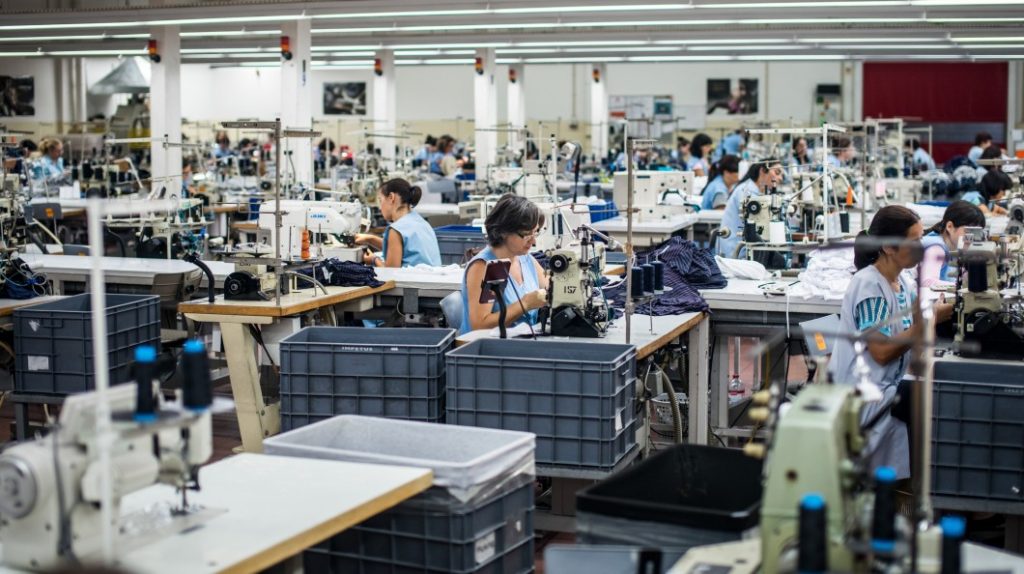Summary:
- Fast fashion implies a rapid and large-scale production of garments at affordable prices, often seen as contradictory to sustainability principles;
- Actually, several actions can be taken to promote sustainability within the fast fashion industry;
- Technology can be an excellent ally to help mitigate waste generation in a fast fashion. Experience the benefits of Audaces360 for free and discover its potential impact!

The fast fashion industry has gained significant popularity among some of today’s most renowned brands. It is characterized by the mass production of clothing items sold at affordable prices.
These garments often transition swiftly from the runway to production, with the capability to be manufactured within weeks or even days. This rapid process is facilitated by extensive global supply chains, which can be challenging to trace.
Fast fashion has frequently been linked to substantial environmental consequences. The choice of fabrics, production techniques, and the use of chemical substances often result in detrimental impacts on ecosystems. Pollution of rivers and surrounding land near factories is common, and the garments themselves may pose risks to skin health.
However, is this always the case? Can fast fashion and sustainability ever be associated with one another? If this topic interests you, read on!
Sumário
Fast fashion and sustainability: does one exclude the other?

Although fast fashion and sustainability are often seen as opposing concepts, this article aims to explore the topic from a new perspective and uncover potential possibilities.
Fast fashion operates at a much faster pace than the lifespan of a garment, leading consumers to discard large quantities of clothes to make room for the latest trends.
“The True Cost” documentary highlights that we now purchase over 80 billion items of clothing annually, a staggering 400% increase compared to 20 years ago.
Effecting change requires a shift in consumer demand and purchasing habits.
However, considering the widespread popularity and accessibility of the fast fashion model, which has made fashion affordable and inclusive for many groups, it is important to explore how this industry can improve its practices while respecting the environment.
A research group from the Desautels Faculty of Management has demonstrated that even within the realm of fast fashion, there are avenues for sustainability.
Various aspects, including ethical and social responsibility, as well as economic benefits, contribute to the impetus for change.
The integration of Environmental, Social, and Governance (ESG) factors, for instance, has made it financially advantageous to reevaluate business models through a sustainable lens.
Learn more: Why consider sustainable consumption and production for your company?
How can fast fashion companies become more sustainable?
Fashion, particularly fast fashion, has long been perceived as incompatible with sustainability.
Michele Ricchetti, an economist, and founder of the Sustainability Lab, aptly points out that “the fashion industry consumes abundant natural resources and generates waste, while sustainability aims for resource conservation and zero waste”.
Numerous studies have highlighted the adverse environmental impacts associated with the fast fashion model.
The main ones are:
- Fabrics based on the cost criterion, not taking into consideration the possible environmental damage in producing them;
- Use of harsh chemicals in dyeing and manufacturing;
- Use of pesticides that poison rivers and land near factories;
- Huge water usage (1.5 trillion liters per year);
- Application of toxic dyes or aggressive substances to color or whiten fabrics;
- Release of microplastics into the oceans in the washing phase of synthetic fibers;
- Pollution in the process of disposing of clothes or textile waste (92 million tons every year).
However, we want to suggest some sustainable actions that could help make fast fashion more sustainable, by intervening at all stages of the supply chain.
By embracing responsible material selection, chemical management, sustainable agriculture, water conservation, eco-conscious manufacturing, and responsible disposal, these companies can transition towards a more sustainable future.
Let’s see some good practices in detail below!
Learn more: How to master sustainable creation and production in the eco-fashion era
Creating long-lasting products
Consumer goods can be categorized into two groups: durable items meant for long-term use, such as coats or televisions, and consumable goods with short lifespans, like chewing gum or cigarettes.
In the realm of fast fashion, there is a concerning trend of equating “used” items with “consumed” items, inadvertently comparing the lifespan of a t-shirt to that of a piece of gum.
Over the past two decades, the average lifespan of clothing has significantly decreased, resulting in consumers purchasing at least twice as many clothes as they did in the year 2000.
This shift can be attributed to the inclination to buy more but use less, driven by marketing strategies employed by fast fashion companies, as well as the poor quality of garments.
To foster sustainability within the fast fashion industry, a primary challenge lies in investing in the creation of more durable products.
This involves improving the choice of fabrics and the construction of garments.
In this sense, companies must prioritize the quality of work processes and ensure fair remuneration for workers to achieve meticulous seams and finishes that require time and attention.
Additionally, slowing down fashion processes is crucial. By reducing the influx of new garments and focusing on lasting trends and timeless pieces, fast fashion companies can produce items that can be reused over time without going out of style.
Learn more: What ESG score is and how to apply it to your clothing company
Embracing biodegradable materials

To enhance sustainability in the fast fashion industry, it is crucial to prioritize the selection of fabrics.
Currently, polyester, derived from petroleum, dominates the fast fashion market. Unfortunately, it contributes significantly to the presence of microplastics in our oceans, as it is non-biodegradable and lacks breathability, posing risks to both human health and the environment.
Surprisingly, cotton, often considered a natural and biodegradable fabric, ranks as the second most polluting material in fast fashion.
Unsustainable cultivation and harvesting practices, excessive pesticide use, and soil degradation contribute to its environmental impact.
For instance, cotton production in the United States, China, and India alone generates carbon dioxide emissions equivalent to 1.8 tons for every ton of cotton produced.
To be more sustainable, fast fashion should invest in biodegradable fabrics and materials, such as:
- Nettle fibres, from which excellent textile fibers are obtained such as Ramper or Allo Fibra, very soft, resistant and breathable;
- Orange fiber, derived from the wet residue that remains at the end of the citrus juice production, also used by Salvatore Ferragamo for a collection;
- Jusi, obtained from banana plant stems, has traditionally been used in Japanese kimono packaging.
- QMilk, a fabric derived from casein, a protein found in milk. This material requires minimal water usage and generates no production waste.
In addition to these alternatives, organic cotton can still play a significant role in sustainable fashion. By ensuring cotton is sourced from organic farming methods, which avoid harmful pesticides and prioritize soil health, its environmental impact can be minimized.
Promoting responsible and environmentally friendly disposal
A major issue in the fast fashion industry is the staggering amount of waste generated. “Fast” fashion, as its name suggests, was designed to be short-lived, resulting in garments often being treated as disposable items that quickly fall out of fashion and are replaced.
Fast fashion waste manifests in two forms. First, unsold goods are frequently disposed of through burning, releasing harmful fumes into the environment.
Second, the so-called unwanted goods: garments that become worn out, damaged, or broken are typically discarded rather than repaired, as the cost of repair often exceeds the value of the garment.
Approximately 70 million tons of clothing are discarded each year, with 48% of these garments still fully functional and capable of serving their primary purpose.
Recycling textiles, especially those made from polyester or mixed fibers, proves challenging.
While proper disposal is certainly a necessary step, it alone is insufficient to address the sustainability issue.
In Italy, the obligation to collect textile waste was implemented in 2022, surpassing the European deadline of 2025. However, monitoring the correct disposal of clothing remains difficult in other parts of the world.
Exploring avenues to give clothing a new lease on life is an interesting approach.
Participating in flea markets or utilizing apps that facilitate the redistribution of used clothing can provide second chances for garments.
Additionally, you can donate clothes to organizations such as Caritas or other charitable entities that support individuals in need.
Learn more: How to properly dispose of your clothing company’s textile waste?
Make your fast fashion company more sustainable with Audaces360

Technology is key to achieving sustainability within your fast fashion company.
Innovative solutions offered by Audaces can revolutionize your production processes, optimize resource utilization, and minimize waste, all while prioritizing the environment and the future of our world and of those who will come.
Audaces360
Audaces360 is technology designed to seamlessly integrate all aspects of the fashion value chain, from collection planning to cutting, by leveraging tools that reduce costs and streamline processes.
With the platform it is possible to reduce waste in the garment design phase, by utilizing Audaces Fashion Studio, where you can develop garment models directly on the computer while ensuring maximum realism through sewing and simulations using Audaces 3D.
This empowers your team to visualize and refine designs without the need for physical samples, saving time, materials, and resources.
Audaces Marker, another powerful tool within the Audaces360 platform, automates marker creation. With it, you can achieve fabric savings of up to 13% compared to manual methods.
The ability to manage your entire creation and production process in real-time, even remotely, with Audaces Isa, coupled with the integration of technical sheets and automatic pre-cost calculations using Audaces Idea, maximizes efficiency while minimizing errors and rework.
Join us in our mission to make your processes more sustainable and embrace Audaces360 to drive positive change within your fast fashion company!
Conclusion
Taking decisive action to reduce the fashion industry’s impact on the environment is crucial and urgent.
This transformation requires a dual effort: consumers must make conscious choices to reduce overconsumption and demand durable, high-quality garments, while fast fashion companies must overhaul their production processes.
Surely a lot can be done, for example, by the careful selection of quality fabrics and the creation of durable garments that stand the test of time.
And technology can play a pivotal role in waste reduction, driving positive change within fast fashion companies.
If you’re interested in learning more about efficient and sustainable production practices, we invite you to download our complimentary e-book.
Just fill out the form below and download it for free:
FAQ
Fast fashion refers to the rapid and mass production of clothing, typically at affordable or low prices.
While fast fashion and sustainability are often viewed as conflicting concepts, it is indeed possible for fast fashion companies to adopt practices that promote sustainability.
Fast fashion companies can enhance their sustainability by taking several steps, including embracing biodegradable fabrics, creating more durable garments, implementing proper waste disposal, and leveraging specialized technologies that optimize production processes and resource efficiency.










